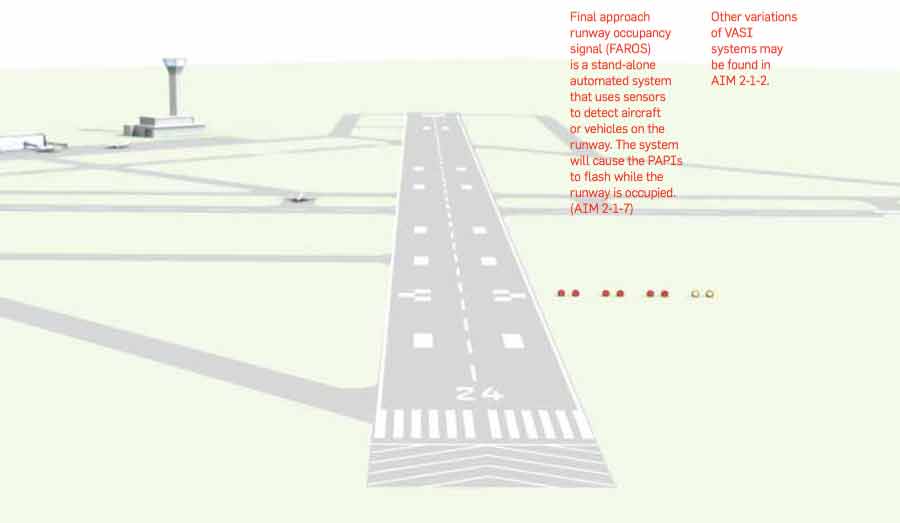
Since the PVASI consists of a single light source, pilots should exercise care to properly locate and identify the light signal. Bryan Christie Design
The visual approach slope indicator (VASI) and precision approach path indicator (PAPI) are light systems on the side of a runway threshold that provide visual descent guidance information during approach. Here are the particulars of the different types of path-lighting systems:
Two-Bar Visual Approach Slope Indicator (VASI)
Two-bar VASI installations provide one visual glidepath, which is normally set at 3 degrees. VASI lights are visible from 3 to 5 miles during the day and 20 miles or more at night. They provide safe obstruction clearance within ±10 degrees of the extended runway centerline and to 4 nm from the runway threshold.
Three-Bar VASI
Three-bar VASIs provide two visual glidepaths. The lower glidepath is provided by the near and middle bars and is normally set at 3 degrees; the upper glidepath, provided by the middle and far bars, is normally 0.25 degrees higher. This higher glidepath is intended for use only by high-cockpit aircraft to provide a sufficient threshold crossing height. Although normal glidepath angles are 3 degrees, angles at some locations may be as high as 4.5 degrees to give proper obstacle clearance. This system provides safe obstruction clearance within ±10 degrees of the extended runway centerline and 4 nm from the runway threshold.
VASI variations may consist of two, four, six, 12 or 16 light units.
Precision Approach Path Indicator (PAPI)
PAPIs use light units similar to the VASI but are installed in a single row of either two or four light units. They have an effective visual range of about 5 miles during the day and up to 20 miles at night. They provide safe obstruction clearance within ±10 degrees of the extended runway centerline and to 4 sm from the runway threshold. (Obstruction clearance is measured in statute miles for PAPIs and nautical miles for VASIs.)
Tricolor Systems
Tricolor systems normally consist of a single light unit projecting a three-color visual approach path into the final approach area of the runway upon which the indicator is installed. The below-glidepath indication is red, the above-glidepath indication is amber and the on-glidepath indication is green. These types of indicators have a useful range of approximately one-half to 1 mile during the day and up to 5 miles at night, depending upon the visibility conditions.
Pulsating Systems
Pulsating visual approach slope indicators (PVASI, aka PLASI) normally consist of a single light unit projecting a two-color visual approach path into the final approach area of the runway upon which the indicator is installed. The on-glidepath indication is a steady white light. The slightly below-glidepath indication is a steady red light. If the aircraft descends farther below the glidepath, the red light starts to pulsate. The above-glidepath indication is a pulsating white light. The pulsation rate increases as the aircraft gets farther above or below the desired glideslope. The useful range is about 4 miles during the day and up to 10 miles at night.

Sign-up for newsletters & special offers!
Get the latest FLYING stories & special offers delivered directly to your inbox






